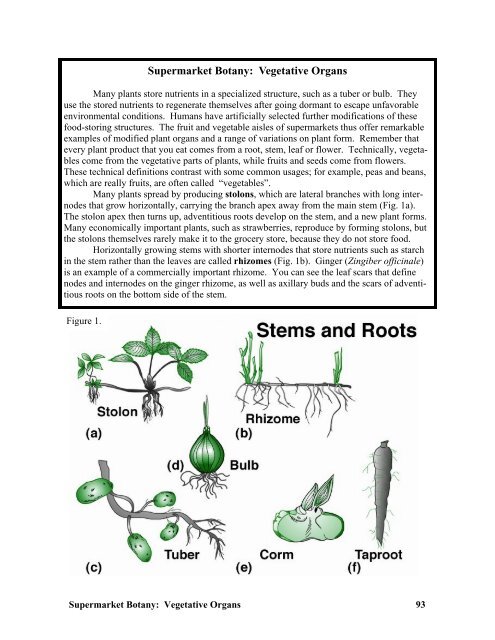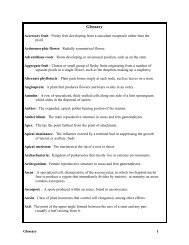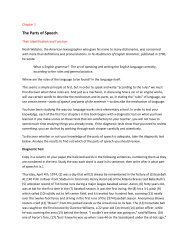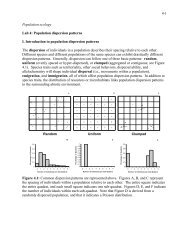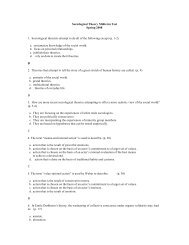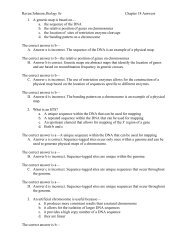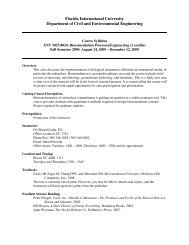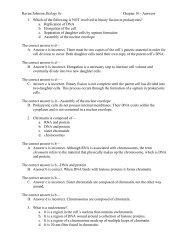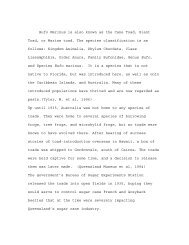Supermarket Botany: Vegetative Organs
Supermarket Botany: Vegetative Organs
Supermarket Botany: Vegetative Organs
Create successful ePaper yourself
Turn your PDF publications into a flip-book with our unique Google optimized e-Paper software.
<strong>Supermarket</strong> <strong>Botany</strong>: <strong>Vegetative</strong> <strong>Organs</strong>Many plants store nutrients in a specialized structure, such as a tuber or bulb. Theyuse the stored nutrients to regenerate themselves after going dormant to escape unfavorableenvironmental conditions. Humans have artificially selected further modifications of thesefood-storing structures. The fruit and vegetable aisles of supermarkets thus offer remarkableexamples of modified plant organs and a range of variations on plant form. Remember thatevery plant product that you eat comes from a root, stem, leaf or flower. Technically, vegetablescome from the vegetative parts of plants, while fruits and seeds come from flowers.These technical definitions contrast with some common usages; for example, peas and beans,which are really fruits, are often called “vegetables”.Many plants spread by producing stolons, which are lateral branches with long internodesthat grow horizontally, carrying the branch apex away from the main stem (Fig. 1a).The stolon apex then turns up, adventitious roots develop on the stem, and a new plant forms.Many economically important plants, such as strawberries, reproduce by forming stolons, butthe stolons themselves rarely make it to the grocery store, because they do not store food.Horizontally growing stems with shorter internodes that store nutrients such as starchin the stem rather than the leaves are called rhizomes (Fig. 1b). Ginger (Zingiber officinale)is an example of a commercially important rhizome. You can see the leaf scars that definenodes and internodes on the ginger rhizome, as well as axillary buds and the scars of adventitiousroots on the bottom side of the stem.Figure 1.<strong>Supermarket</strong> <strong>Botany</strong>: <strong>Vegetative</strong> <strong>Organs</strong> 93
Tubers also store nutrients in the stems but only in a localized part of the stem (Fig.1c). The most important tuber in the world is the potato (Solanum tuberosum). The potato isthe swollen, starch-storing end of a narrow branch that grows into the ground from the base ofthe potato plant. The small ridges that spiral around the stem are the scars of leaves producedon the stem, and in the axil of each scar is a cluster of three axillary buds. One end of the potatohas a scar or remnant of the narrow stem, while the other has the apical meristem of thebranch.Some plants make root tubers (or tuberous roots) instead of stem tubers (Fig. 1f).Sweet potatoes (Ipomoea batatus) are an example. If you look at a sweet potato, you can seeit is swollen and has lateral roots or lateral root scars. One indication that these are roots isthat the scars don’t have buds in their axils, as would leaves or leaf scars. They also don’thave a regular arrangement or phyllotaxy, as you would expect of leaves. Cassava (Manihotesculenta) is an important root tuber crop in the tropics.Bulbs are modified shoots that grow vertically and store nutrients in the leaves ratherthan the stems (Fig. 1). Onions (Allium cepa) and garlic (Allium sativum) are both bulbs, butdifferent sets of leaves are used for storage in each case. If you cut an onion open lengthwise,you see the short stem, with the fleshy leaf bases attached. The leaf bases had elongated greenblades (the green part we eat in green onions), but these parts have dried up and fallen off inbulbous onions. The brown layers covering the outside of the onion are also dried up leafbases. Inside the brown leaf bases are the succulent leaf bases that we eat. Each base wrapsaround the stem completely, so it is a sheathing leaf base. Adventitious roots grow out of thebottom of the stem; we can see remnants of these at the base of the bulb.Garlic is also a bulb, but in garlic nutrients are stored in the leaves of axillary budsrather than in leaves on the main stem. As you take a garlic bulb apart, you pull off dry, paperyleaf bases, similar to the brown leaf bases on the outside of an onion. These leaves hadmultiple buds in their axils; the buds form the cloves of the garlic. Like the potato, each leafusually has more than one bud per leaf axil. Each axillary bud or clove has a papery first leaf,then the second leaf is succulent and produces the garlic flavor. If you section the garlicclove, you can see more leaves and the shoot tip inside.<strong>Supermarket</strong> <strong>Botany</strong>: <strong>Vegetative</strong> <strong>Organs</strong> 94
Vegetables belonging to the species Brassica oleracea provide a remarkable exampleof artifical selection (Fig. 2). Kale, Brussels sprouts, cabbage, kohlrabi, broccoli and cauliflowerall belong to B. oleracea, but in each of these vegetables a different part of the shoothas been selected to enlarge and be used as food for humans. We eat the leaves of kale andcabbage, the axillary buds of Brussels sprouts, and the expanded stem of kohlrabi. Broccoli isan immature inflorescence, while cauliflower is an inflorescence with aborted flowers.Other plants are cultivated for their edible leaves. These include lettuce (Lactuca sativa),spinach (Spinacia oleracea), and celery (Apium graviolens). In lettuce and spinach weeat the entire leaf, whereas the edible portion of celery is the petiole of the leaf. If you look atthe inner base of a celery stick, you often find an axillary bud, which was torn off the stemwith the celery stick.Figure 2.<strong>Supermarket</strong> <strong>Botany</strong>: <strong>Vegetative</strong> <strong>Organs</strong> 95


